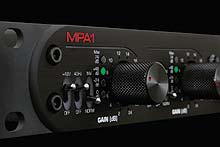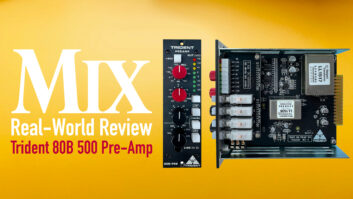
The 2-channel MPA1 has all you would expect from a preamp, plus a headphone out with volume control.
Since 1983, Benchmark has been manufacturing leading-edge specialty audio products — notably the DAC1, which has become a standard for digital-to-analog, reference-grade converters. Sharing the same “system 1” half-rack frame design as the DAC1 is the MPA1 microphone preamplifier. The MPA1 is designed to be an ultra-pure 2-channel microphone preamplifier capable of capturing every detail of a source.
Though most of the features are pretty standard, many of them have some very innovative twists. For instance, the phantom-power section features a multistage protection circuit that absorbs the phantom-power surges caused by shorts and plugging/unplugging microphones with +48 volts engaged. The most unique feature is the stepped resistor gain control. The continuously rotating, detented knobs provide 74 dB of gain in 2dB increments. (The knob has four stages: +0, +24, +48 and +74 dB.) Being able to have recallable detent settings with that degree of precision is a great feature, particularly for a preamp so adept at stereo miking. Other controls include polarity inversion and a highpass filter (uniquely set at 40 Hz). A headphone out with volume control is also included on the front panel.
One Clean Machine
The well-constructed MPA1 showcases craftsmanship and quality components: Knobs and switches all have a good feel, and the heavy casing is tightly assembled. My first use matched up the Benchmark with a pair of DPA 4011s on an acoustic guitar. A producer with whom I work regularly was doing overdubs for a radio remix, and I thought this would be a great opportunity to see what the Benchmark could do. The detail was astonishing, picking up every nuance of the guitar but without sounding cluttered or unclear. It was smooth and balanced from top to bottom, providing an accurate but warm image. I wouldn’t say that it had “character” because that would denote that the Benchmark somehow colored the sound, but the tone was incredibly full and three-dimensional. While the MPA1 didn’t alter the sound, it somehow avoided having the sterile feel associated with many “clean” preamplifiers. The picking was crisp and clear, while the low end was big yet focused. Nothing was exaggerated, but the entire guitar sounded larger than life.
Inspired by these results, I tried the Benchmark on some background vocal takes. I patched a BLUE Baby Bottle into the Benchmark to see how it would fare. I was once again surprised by how full and rich the tracks were. The presence of the top end was spectacular, while the midrange and lows were big, but perfectly behaved. The precision gain settings were particularly useful on vocals, making it possible to get right up to the edge of the converter. I was amazed by how complex the vocals were for a preamp that would fall into the “clean pre” category. The Benchmark’s balanced and detailed characteristics created one of those vocal sounds that you can put anywhere in the mix but still hear it clearly. Although that could be a good or bad thing for background vocals, it would be invaluable when trying to capture a subtle lead vocal.
Wrap Up
The Benchmark is a world-class microphone preamp that is surprisingly versatile. It was phenomenal on vocals and acoustics, as well as everything else I tested it on. Unique features like the precision stepped-input gains add to the unit’s usefulness. The 40Hz highpass filter is useful for eliminating room and mechanical noise without cutting off the extension of sources with more low end. The half-rack design, along with unit couplers and blanks, also make this mic pre easy to handle while allowing for a variety of rackmounted configurations. The flexibility of the MPA1’s form and function would make this unit a valuable addition to any studio or field recording kit.
Matt Bishop is a staff engineer at Alford Media Services in Dallas, where he mixes for a variety of local and national artists and churches.

We ran the following tests on the Benchmark MPA1 stereo microphone preamp using an Audio Precision APx500 test and measurement system. The results mirrored what we found in our listening tests: at full gain, the MPA1 provides plenty of clean signal at high output.

At one click below distortion on input/output, we were able to measure +26.4 dBu of output level, out of the MPA1

The MPA1’s frequency response was razor flat with less than 0.02dBu of variance between 20Hz and 50kHz

At full gain, distortion measured very low at .007%, referenced at 1kHz







